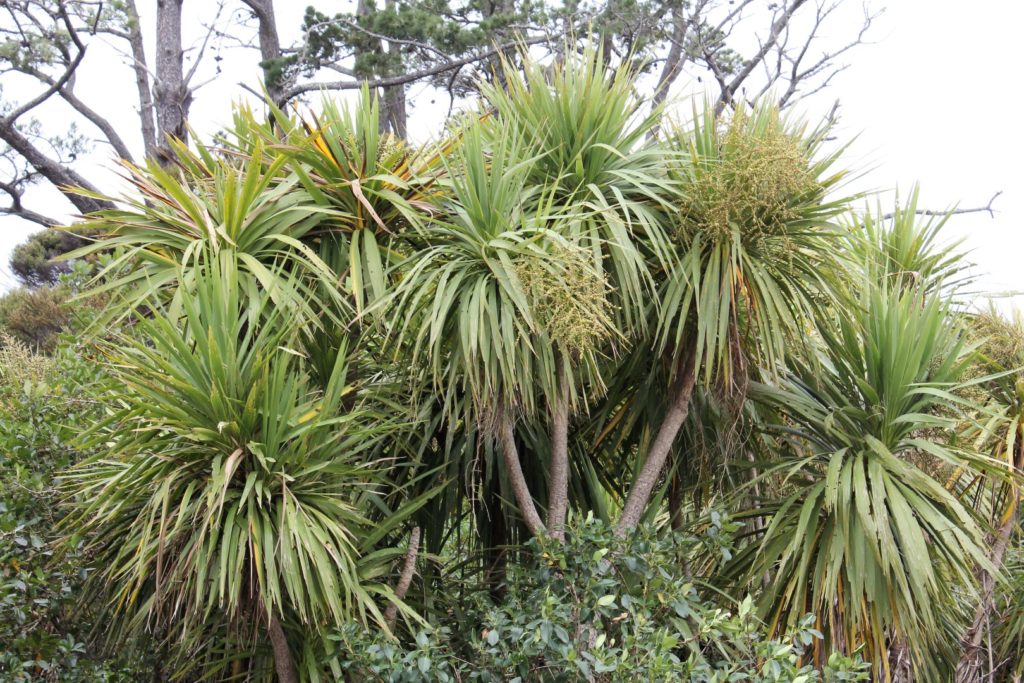- About Us
- Our Work
- Tree Info
- Get Involved
- Blog
- Volunteer
- Support Us
By Canopy Team on September 24, 2018

Green dracaena via Kauri Park Nurseries
Tree Spotlight Series: Follow along as we learn about the fascinating trees that live among us. This series is in partnership with Rhee Lab in the Plant Biology Department of the Carnegie Institution for Science.
Other posts in the series: Ginkgo biloba, Douglas fir, Giant sequoia, Chinese tallow, Silver-dollar gum, and Monterey pine.
Cordyline australis, also called the green dracaena, is a large, hardy tree native to New Zealand. This tree is not only the signature of many local landscapes, but also a crucial aspect of Māori cultures in New Zealand. While the tree is important to these cultures, the main draw of planting this tree is its noteworthy and unique appearance.
The green dracaena grows to be up to 66 feet tall, about 6 stories, and has a stout, dark grey trunk, which can be almost 7 feet in diameter. The white flowers grow on slender stems that branch from the main trunk, which become white berries.
The most fascinating aesthetic of the species are its leaves: green dracaena’s long, narrow leaves are sword shaped appendages that can grow up to over 3 feet long. This visual aspect distinguishes it from most other trees with smaller leaves, marking it as an ornamental tree with a unique flair in California.
The green dracaena are relics from an influx of tropical plants that arrived to New Zealand millions of years ago. As a result, they evolved in response to local climate, geology, and other factors, resulting in the species having slight differences depending on location. For example, in New Zealand, the leaves are not only longer and narrower the further south they are found, but there is also a greater amount of red or brown pigmentation in that part of the country.
The species’s origin also explains how the trees can be found in a wide variety of habitats, from volcanoes in New Zealand’s North Island, to the chillier climates down south. Furthermore, the tree develops structures called rhizomes under the ground that generally function to renew the trunk, but can also hasten regeneration after a fire has eliminated competing plants.
The green dracaena has a wide variety of uses. First, it has been historically used as a pioneer species, as settlers in Canterbury grew the tree where other plants had trouble growing, and the tree’s fallen leaves helped increase the fertility of the soil. Furthermore, the species has a major role in biodiversity, as many plants and animals depend on this species for nutrients. Notably, the nectar is used by bees to produce a light honey to feed their young and increase the size of the hive early in the summer.
For local Māori cultures in New Zealand, it has been used as food products, as the stems and fleshy rhizomes are high in natural sugars. Additionally, fiber extracted from the leaves is valued for its strength and durability, especially in seawater, and has been used for anchor ropes and fishing lines in indigenous cultures. Finally, the species has been cultivated into many different aesthetic variations, including the popular “Red Star”, highlighting the tree’s popularity as an ornamental tree.

Despite the species’s humble origins across the world, the green dracaena has spread as a result of the tree’s unique and appealing aesthetics. This species not only played a crucial role in the indigenous cultures of New Zealand, but also exhibits unmistakable appeal to our modern urban environments.

Ankush Bharadwaj is a 2018 summer intern at the Rhee Lab in the Plant Biology Department of the Carnegie Institution for Science. He is currently an undergraduate student majoring in Microbiology, Immunology, and Molecular Genetics at the University of California, Los Angeles. His hobbies include being outdoors, where he usually spends his time kayaking, hiking, or simply skateboarding around.